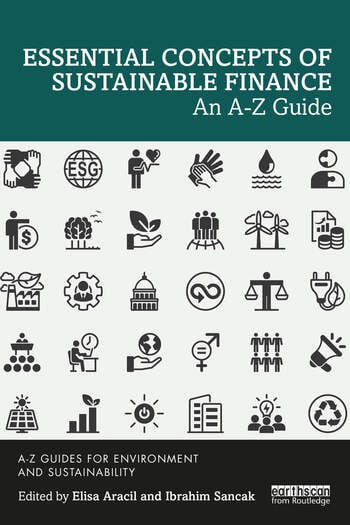Sustainability Starts
with Knowledge
Explore
Learn
Lead
|
for a
Sustainable Future
Books

You may access the review here:
https://www.aimr.asia/magazine_article/essential-concepts-of-sustainable-finance-an-a-z-guide/
You may access the book here:
Articles
Author: Dr. Ibrahim E. Sancak
Abstract
This study zooms in on sustainability transformation processes by deploying Stouten, Rousseau, and Cremer's (SRC) model of ten key evidence-based steps in managing planned organizational change as an anchor to develop a sequential sustainability transformation model (STM) for business organizations. The study highlights phases and steps in sustainability transformation with environmental, social, and governance (ESG) factors. Implementing planned organizational change models in sustainability transformation provides new evidence that the governance (G) factor plays the most significant role among ESG factors. Moreover, the study reveals the importance of developing more robust metrics to gauge governance factors. This study also connects change management with sustainability transformation and addresses future research in this nexus.
Keywords: Change Management, Business Organizations, Environmental, Social and Governance (ESG) Factors, Sustainability Transformation
You may access the article here:
https://www.sciencedirect.com/science/article/abs/pii/S0301479722027384
Author: Dr. Ibrahim E. Sancak
Abstract
This paper analyzes the EU Sustainability Taxonomy (EUST) in the context of Edmans' Rational Sustainability Principles. Edmans' "rational sustainability" concept redefines sustainability with ten principles. The EUST, introduced in 2020 by the EU as part of its sustainable finance reform, aims to classify enterprise-level economic activities based on their sustainability characteristics. As a regulation-based tool, its sustainability classifications differ significantly from market-driven ESG ones by providing net positive environmental contribution indicators in terms of revenue, capital expenditures, and operating expenditures for business organizations. Our analysis demonstrates that the EUST is consistent with these newly introduced principles, implying that the EUST might prevail over today's ESG ratings and tools in the rational sustainability world. As for the research and practice implications, the EUST data might provide profoundly new information about sustainability and help resolve confusing findings of mainstream ESG studies, enabling us to develop more robust knowledge and more reliable sustainability policies.
Keywords: ESG, EU Taxonomy, sustainability, sustainable finance, sustainable investing, sustainability reporting
You may access the article here:
https://link.springer.com/article/10.1057/s41310-021-00111-7
Author: Dr. Ibrahim E. Sancak
Abstract
The European Union (EU) has announced comprehensive sustainability reform packages with strong indications toward a more sustainable economy since 2016. One of the cornerstone reform packages in this way is the Action Plan on Financing Sustainable Growth, introduced in 2018, addressing ten interconnected actions. “Establishing an EU classification system for sustainable activities” stays at the top of these ten reform areas. It marched into regulatory life with the Taxonomy Regulation (EU/2020/852) taking effect on 12 July 2020. This regulation builds the regulatory foundation of the EU Sustainability Taxonomy (EUST) and interacts with other cornerstone sustainable finance regulations, such as the Corporate Sustainability Reporting Directive (CSRD) and Sustainable Finance Disclosure Regulation (SFDR). We focus on the EUST, contemplating its implications for small and medium-sized enterprises (SMEs). We are convinced that the probable impacts of the EUST on SMEs can be colossal and extend beyond the bloc’s territories implying existential business risks and unprecedented opportunities.
Keywords: EU Sustainability Taxonomy, Small and Medium-sized Enterprises (SMEs), Sustainable Finance, Sustainability Reporting, ESG, European Green Deal, Sustainability
You may access the article here:
Author: Dr. Stefan Zeranski and Dr. Ibrahim E. Sancak
Abstract
The U.S. financial markets faced an unprecedented rapid decline and recovery on May 6, 2010, known as the May 6 flash crash. Roughly one trillion $ market value in less than thirty minutes vanished with the biggest one-day point decline in the history of the DJIA at the time. Since the market events took place in electronic markets, and algorithmic trading and high-frequency trading, parts of FinTech, played significant roles, we handle the May 6 flash crash from the FinTech, SupTech, and financial supervision perspectives. With the flashback method, we analyzed the reactions of market participants, media, and two financial supervisors, the SEC, and the CFTC, to the market crash. We find that the technological imbalance between financial markets or institutions and their supervisors drove the markets in uncertainty, hence in a fear and panic environment. Since the imbalance has not diminished yet, the same risks still exist. As a remedy, we introduce a new concept and model with a well-functioning SupTech system to cope with the May 6 type FinTech crises.
Keywords: Supervisory Technology, SupTech, FinTech, RegTech, Financial Supervision, Financial System, Prudential Supervisory Disclosure, Financial Authority, Digital Finance, May 6 Flash Crash, FinTech Crises
You may access the article here:
https://link.springer.com/article/10.1057/s41310-021-00111-7

